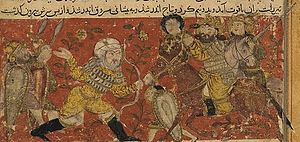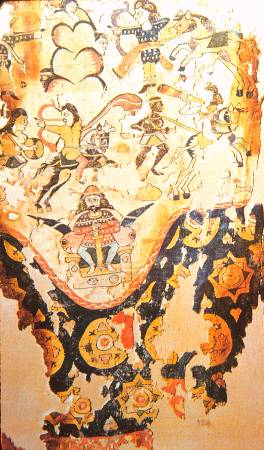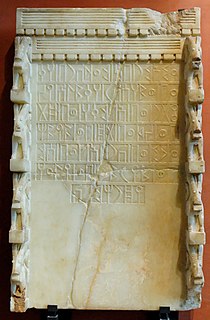| Abyssinian–Persian wars | |||||||||
|---|---|---|---|---|---|---|---|---|---|
 | |||||||||
| |||||||||
| Belligerents | |||||||||
| Sasanian Empire Himyarite Kingdom | Aksumite Empire | ||||||||
| Commanders and leaders | |||||||||
| Sayf ibn Dhi-Yazan † | Alla Amidas | ||||||||
In the late sixth century, Sasanian Empire of Persia and the Ethiopia-based Aksumite Empire fought a series of wars over control of the Himyarite Kingdom in Yemen, Southern Arabia. After the Battle of Hadhramaut and the Siege of Sana'a in 570, the Aksumites were expelled from the Arabian peninsula. They had re-established their power there by 575 or 578, when another Persian army invaded Yemen and re-established the deposed king on his throne as their client. It marked the end of Ethiopian rule in Arabia.

The Sasanian Empire, also known as the Sassanian, Sasanid, Sassanid or Neo-Persian Empire, was the last kingdom of the Persian Empire before the rise of Islam. Named after the House of Sasan, it ruled from 224 to 651 AD. The Sasanian Empire succeeded the Parthian Empire and was recognised as one of the leading world powers alongside its neighbouring arch-rival the Roman-Byzantine Empire for a period of more than 400 years.

Ethiopia, officially the Federal Democratic Republic of Ethiopia, is a country in the northeastern part of Africa, popularly known as the Horn of Africa. It shares borders with Eritrea to the north, Djibouti to the northeast, and Somalia to the east, Sudan and South Sudan to the west, and Kenya to the south. With over 102 million inhabitants, Ethiopia is the most populous landlocked country in the world and the second-most populous nation on the African continent that covers a total area of 1,100,000 square kilometres (420,000 sq mi). Its capital and largest city is Addis Ababa, which lies a few miles west of the East African Rift that splits the country into the Nubian Plate and the Somali Plate.

The Kingdom of Aksum was an ancient kingdom located in what is now Tigray Region and Eritrea. Axumite Emperors were powerful sovereigns, styling themselves King of kings, king of Aksum, Himyar, Raydan, Saba, Salhen, Tsiyamo, Beja and of Kush. Ruled by the Aksumites, it existed from approximately 100 AD to 940 AD. The polity was centered in the city of Axum and grew from the proto-Aksumite Iron Age period around the 4th century BC to achieve prominence by the 1st century AD. Aksum became a major player on the commercial route between the Roman Empire and Ancient India. The Aksumite rulers facilitated trade by minting their own Aksumite currency, with the state establishing its hegemony over the declining Kingdom of Kush. It also regularly entered the politics of the kingdoms on the Arabian Peninsula and eventually extended its rule over the region with the conquest of the Himyarite Kingdom. The Manichaei prophet Mani regarded Axum as one of the four great powers of his time, the others being Persia, Rome, and China.
Around 520, Kaleb of Axum had sent an expedition to Yemen against the Jewish Himyarite king Dhu Nuwas, who was persecuting the Christian community there. Dhu Nuwas was deposed and killed and Kaleb appointed a Christian Himyarite, Esimiphaios ("Sumuafa Ashawa"), as his viceroy. However, around 525 this viceroy was deposed by the Aksumite general Abraha. After Abraha's death, his son Masruq Abraha continued the Axumite vice-royalty in Yemen, resuming payment of tribute to Axum. However, his half-brother Ma'd-Karib revolted. After being denied by Justinian, Ma'd-Karib sought help from Khosrow I, the Sasanian Persian Emperor.

Kaleb is perhaps the best-documented, if not best-known, King of Axum, a kingdom that was situated in modern-day Eritrea and Tigray, Ethiopia.

Yemen , officially known as the Republic of Yemen, is a country at the southern end of the Arabian Peninsula in Western Asia. Yemen is the second-largest Arab sovereign state in the peninsula, occupying 527,970 square kilometres. The coastline stretches for about 2,000 kilometres. It is bordered by Saudi Arabia to the north, the Red Sea to the west, the Gulf of Aden and Guardafui Channel to the south, and the Arabian Sea and Oman to the east. Yemen's territory includes more than 200 islands.

The Ḥimyarite Kingdom or Ḥimyar, historically referred to as the Homerite Kingdom by the Greeks and the Romans, was a kingdom in ancient Yemen. Established in 110 BCE, it took as its capital the ancient city of Zafar, to be followed at the beginning of the 4th century by what is the modern-day city of Sana'a. The kingdom conquered neighbouring Saba' (Sheba) in c. 25 BCE, Qataban in c. 200 CE, and Haḍramaut c. 300 CE. Its political fortunes relative to Saba' changed frequently until it finally conquered the Sabaean Kingdom around 280. Himyar then endured until it finally fell to invaders from the Kingdom of Aksum in 525 CE.
Khosrau sent his general Vahrez and his son Nawzadh to Yemen at the head of a small expeditionary force of eight hundred cavalrymen of Dailamite origin, in one version men of good birth who had been consigned to prison but were now given a chance to redeem themselves by achieving victory. [1] [2] .
The Persian army, onboard eight ships, sailed around the coasts of the Arabian peninsula; and, although two of the ships were wrecked, the rest landed in Hadramaut. During the invasion, Nawzadh was killed, [3] which made Vahriz furious at Masruq, the Ethiopian ruler of Yemen. Vahriz then met Masruq in battle and killed the latter with an arrow at Battle_of_Hadhramaut, which made the Ethiopians flee.

The Battle of Hadhramaut took place between the armies of the Sassanid Empire under the command of Spahbed Vahrez and Aksumite forces under King Masruq ibn Abraha in 570. The Aksumite army was defeated by the Sassanids and Masruq was killed.

He then approached Sana'a, where he is known to have said: "My banner shall never enter [a town] lowered! Break down the gateway!"
After having captured Sana'a, Vahrez restored Sayf ibn Dhi-Yazan to his throne as a vassal of the Sasanian Empire. [2] Al-Tabari reports that the main reason behind victory of Vahrez over the Axumites was the use of the panjigan (probably a ballista equipped with heavy darts), a piece of military technology with which the local peoples were utterly unfamiliar. After having conquered Yemen, Vahrez then returned to Persia with a great amount of booty. [4]

Abū Murra Sayf bin Dhī-Yazan was a Himyarite king of Yemen who lived between 516 and 578 CE, known for ending Aksumite rule over Southern Arabia with the help of the Sassanid Empire..

AbūJaʿfar Muḥammad ibn Jarīr al-Ṭabarī was an influential Persian scholar, historian and exegete of the Qur'an from Amol, Tabaristan, who composed all his works in Arabic. Today, he is best known for his expertise in Qur'anic exegesis, Islamic jurisprudence and world history, but he has been described as "an impressively prolific polymath. He wrote on such subjects as poetry, lexicography, grammar, ethics, mathematics, and medicine."

The ballista, plural ballistae, sometimes called bolt thrower, was an ancient missile weapon that launched a large projectile at a distant target.
However, in 575 or 578, the vassal king was killed by the Ethiopians, which forced Vahrez to return to Yemen with a force of 4000 men, and expel the Ethiopians once again. He then made Maʿdī Karib, the son of Sayf, the new king of Yemen. Vahriz was then appointed as governor of Yemen by Khosrau I, which would remain in Sasanian hands until the arrival of Islam. Vahriz was succeeded by his son Marzbān as governor of Yemen.
Vahrez made Maʿdī Karib, the son of Sayf, the new king of Yemen. Vahrez was then appointed as governor of Yemen by Khosrau I, which would remain in Sasanian hands until the arrival of Islam. Vahriz was succeeded by his son Marzbān as governor of Yemen.

Dhū Nuwās,, Yosef Nu'as, or Yūsuf Ibn Sharhabeel Syriac Masruq; Greek Dounaas (Δουναας), was a Judaic king of Ḥimyar between 517 and 525-27 CE, who came to renown on account of his military exploits against people of other religions living in his kingdom.

Adulis or Aduli is an archeological site in the Northern Red Sea of Eritrea, situated about 30 miles south of Massawa in the Gulf of Zula. It was the port considered part of the Kingdom of Aksum, located on the coast of the Red Sea. However recent excavation uncovers artifacts that predates the Axumite civilization. These civilization is now known as Adulitarian. Adulis Bay is named after the site. It is thought that the modern town of Zula may be the Adulis of the Aksumite epoch, as Zula may reflect the local name for the Ancient Greek Adulis.
Abraha, also known as Abraha al-Ashram, was an Aksumite army general, then the viceroy of southern Arabia for the Kingdom of Aksum, and later declared himself an independent King of Himyar. Abraha ruled much of present-day Arabia and Yemen from at least 531–547 AD to 555–565 AD.
GDRT was a King of the Kingdom of Aksum, known for being the first king to involve Axum in the affairs of what is now Yemen. He is known primarily from inscriptions in South Arabia that mention him and his son BYGT. GDRT is thought to be the same person as GDR, the name inscribed on a bronze wand or sceptre that was found in an area near Atsbi and Dar'a/Addi-Galamo in northern Ethiopia.
South Arabia is a historical region that consists of the southern region of the Arabian Peninsula, mainly centered in what is now the Republic of Yemen, yet it has also historically included Najran, Jizan, and 'Asir, which are presently in Saudi Arabia, and the Dhofar of present-day Oman.
Boes better known by his title of Vahrez, was a Sasanian general of Daylamite origin attested in the prelude to the Iberian War.

The ancient history of Yemen is especially important because Yemen is one of the oldest centers of civilization in the Near East. Its relatively fertile land and adequate rainfall in a moister climate helped sustain a stable population, a feature recognized by the ancient Greek geographer Ptolemy, who described Yemen as Eudaimon Arabia meaning Fortunate Arabia or Happy Arabia. Between the eighth century BCE and the sixth century CE, it was dominated by six main states which rivaled each other, or were allied with each other and controlled the lucrative spice trade: Saba', Ma'īn, Qatabān, Hadhramaut, Kingdom of Awsan, and the Himyarite Kingdom. Islam arrived in 630 CE and Yemen became part of the Muslim realm.
The Jewish tribes of Arabia were ethnic groups professing the Jewish faith that inhabited the Arabian Peninsula before and during the advent of Islam. It is not always clear whether or not they were originally Israelite in ancestry, genealogically Arab tribes that converted to Judaism, or a mixture of both. In Islamic tradition the Jewish tribes of the Hejaz were seen as the offspring of the ancient Israelites. According to Muslim sources, they spoke a language other than Arabic, which Al-Tabari claims was Persian. This implies they were connected to the major Jewish center in Babylon. Certain Jewish traditions record the existence of nomadic tribes such as the Rechabites that converted to Judaism in antiquity.

The Armies of the Ethiopian Empire have existed since earliest times. Ethiopia maintained a sizable contingent of her forces in her Sabbean Garrisons which expanded out to project power over colonies in Yemen and to protect Caravans or trade routes.
The Siege of Sana'a took place when the Sasanian under military officer Vahrez besieged the Aksumite city of Sana'a in 570.
The Sassanid reconquest of Yemen took place in 575 or 578 after Aksumite men killed Sayf ibn Dhi Yazan after a reign of some four years and took control of Yemen. The rising took place when the protecting Persian garrison withdrew from Yemen. The Sassanids, this time with a force of 4,000 men, managed to reconquer Yemen and install Sayf’s son, Maʿdī Kareb as ruler.

The Al–Qalis Church, Sana'a was a Monophysitic church constructed sometime between 527 and the late 560s in the city of Sana'a. The church's lavish decorations made it an important place of pilgrimage, placing it in competition with Kaaba in Mecca.
Esimiphaios or Samu Yafa' was a local Christian lord, domestically known as Qil, mentioned in an inscription celebrating the burning of an ancient Sabaean palace in Marib to build a church on its ruins. Three new churches were built in Najran alone.
Al-Abnāʾ was the name of a colony in pre-Islamic and early Islamic Yemen who were descended from Sasanian officers and soldiers of Persian origin who intermarried with local Arab women. These Persians had been garrisoned in Sanaa and its surrounding after the Sasanian reconquest of Yemen in the 570s.
Yemen was a province of the Sasanian Empire in Late Antiquity in southwestern Arabia. Its boundaries almost corresponded to present-day Yemen.
| This Asian history–related article is a stub. You can help Wikipedia by expanding it. |